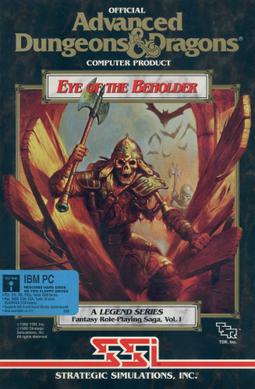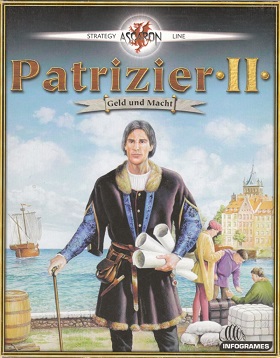
Pool of Radiance is a role-playing video game developed and published by Strategic Simulations, Inc (SSI) in 1988. It was the first adaptation of TSR's Advanced Dungeons & Dragons (AD&D) fantasy role-playing game for home computers, becoming the first episode in a four-part series of D&D computer adventure games. The other games in the "Gold Box" series used the game engine pioneered in Pool of Radiance, as did later D&D titles such as the Neverwinter Nights online game. Pool of Radiance takes place in the Forgotten Realms fantasy setting, with the action centered in and around the port city of Phlan.

Rick Dangerous is a platform game developed by Core Design for the Acorn Archimedes, Amiga, Atari ST, Amstrad CPC, ZX Spectrum, Commodore 64, and MS-DOS. The game was released in 1989 and published by MicroProse on the Firebird Software label in the UK, and on the MicroPlay label in America. It was also published in Spain by Erbe Software. Later, it was released with two other games, Stunt Car Racer and MicroProse Soccer, on the Commodore 64 Powerplay 64 cartridge. The game was followed by a sequel, Rick Dangerous 2, in 1990. Loosely based on the Indiana Jones film franchise, the game received mixed reviews from critics.

Eye of the Beholder is a role-playing video game for personal computers and video game consoles developed by Westwood Associates. It was published by Strategic Simulations, Inc. in 1991, for the MS-DOS operating system and later ported to the Amiga, the Sega CD and the SNES. The Sega CD version features a soundtrack composed by Yuzo Koshiro and Motohiro Kawashima. A port to the Atari Lynx handheld was developed by NuFX in 1993, but was not released. In 2002, an adaptation of the same name was developed by Pronto Games for the Game Boy Advance.

Moonstone: A Hard Days Knight is an action role-playing video game by Canadian independent developer Rob Anderson and published by Mindscape for the Amiga in 1991 and one year later converted to DOS with different sound and music. The title is a play on A Hard Day's Night.

Top Banana is an environmentally-themed platform game produced by Hex and Psycore for the Acorn Archimedes in 1991 and ported to the Amiga and Atari ST in 1992. The chief artist and coder was Miles Visman, with supporting graphics and sound by Karel Dander, and supporting graphics by Sophie Smith, Robert Pepperell and Matt Black. Top Banana was released using recycled cardboard packaging, furthermore being advertised as being the 'first video game with recycled packaging'. Top Banana's plot is about trying to save the environment from pollution using love.

Space Hulk is a 1993 real-time tactical video game for MS-DOS, Amiga and PC-98. The game was based on Games Workshop's 1989 board game of the same name. Set in the fictional Warhammer 40,000 universe, the player directs squads of Space Marines, genetically enhanced armoured soldiers, in their missions to protect the human race from deadly aliens. Space Hulk was developed and published by Electronic Arts, with support from Games Workshop.
Ascaron Entertainment was a video game developer based in Germany. Founded as Ascon by Holger Flöttmann in 1991 and later renamed in October 1996 due to the possible confusion with the Swiss company Ascom AG, the company produced titles primarily for the PC until it became insolvent in 2009.

Hillsfar is a role-playing video game for MS-DOS compatible operating systems, Amiga, Atari ST, and Commodore 64. It was developed by Westwood Associates and published by Strategic Simulations in 1989. It combines real-time action with randomly generated quests and includes elements of the Advanced Dungeons & Dragons fantasy role-playing game. A port to the Nintendo Entertainment System was released in 1993. Hillsfar received mixed reviews from critics.

Powermonger is a real-time strategy video game developed by Bullfrog Productions and published by Electronic Arts. Originally released in 1990 for the Amiga and Atari ST, it was derived from the Populous engine but presented using a 3-dimensional game map.

Obsession is a pinball video game developed and originally published by Unique Development Sweden for the Atari STe on December 2, 1994. It is the first video game to be created by UDS and one of the last official releases for the Atari ST platform after being discontinued in 1993 by Atari Corporation. In the game, players can choose between any of the four available playfields, both of which have their own thematic and main objectives in order to obtain the highest score possible.

Bomberman, also known as Dyna Blaster in Europe, is an action-maze video game originally developed and published by Hudson Soft for the PC Engine in Japan on 7 December 1990 and later in North America for the TurboGrafx-16 by NEC in 1991. Belonging to the Bomberman franchise, it is a re-imagining of the first game in the series starring White Bomberman on a quest to rescue Lisa, the kidnapped daughter of his inventor Dr. Mitsumori, from the castle of Black Bomberman while defeating evil monsters and villains that work for him. The game was later ported to home computers, each one featuring changes compared to the original version. Conversions for other platforms were in development but never released. The title garnered positive reception from critics since its initial release on the PC Engine/TurboGrafx-16 and later on home computers.

The Ancient Art of War in the Skies is a video game developed by Evryware in 1992 for MS-DOS as a sequel to The Ancient Art of War and The Ancient Art of War at Sea. In 1993 conversions were published for Amiga and Atari ST.

Patrician IV is a business simulation game developed by Gaming Minds Studios and part of the Patrician series. It is a game simulating trading, piracy, politics and economics. An expansion pack, Rise of a Dynasty, was released in April 2011.

Kingmaker is a turn-based strategy game published by Avalon Hill in 1993. It was developed by American studio TM Games based on the Kingmaker board game.
Max Design GesMBH was an Austrian video game developer based in Schladming, founded in 1991 by Wilfried Reiter, Albert Lasser and Martin Lasser. The company is best known for creating the Anno series. The company was closed down in 2004.

Ace is a combat flight simulator video game published for the Commodore 64, VIC-20, and Plus/4 in 1985 by Cascade Games. It was ported to the Amstrad CPC, Amstrad PCW, Amiga, and ZX Spectrum.

Patrician II: Quest for Power, entitled Patrizier 2: Geld und Macht in Germany, is the second video game from developer Ascaron in their Patrician series. The sequel to The Patrician, it is a game simulating trading, piracy, politics, and economy. An expansion pack, Patrizier 2: Aufschwung der Hanse, was released in Germany in 2001. A compilation release containing the main game and the expansion was released as Patrizier 2: Gold Edition in Germany in 2002 and as Patrician III: Rise of the Hanse internationally in 2003. A sequel, Patrician IV, was released in 2010.

Brutal Sports Football is a 1993 sports video game developed by Teque London and originally published by Millennium Interactive for the Amiga. It was re-published for MS-DOS and Amiga CD32, and later became the first third-party title published for the Atari Jaguar. The first entry in the Brutal Sports series, the game is a fictional style of football played against human or computer-controlled opponents. It features a different take on american football by emphasising the violent aspect of the sport.

MicroProse Golf is a golf video game developed by The Thought Train and published by MicroProse. It was released in 1991 for Amiga and Atari ST. In 1992, an enhanced MS-DOS version, featuring golf instructor David Leadbetter, was released in the United States as David Leadbetter's Greens and in the United Kingdom as David Leadbetter's Golf. The game's variety was praised, and some critics considered it the best golf game available.

Cover Girl Strip Poker, alternately titled Cover Girl Poker, is a 1991 erotic video game based upon five-card strip poker and originally developed and self-published by Emotional Pictures; it was released for the Amiga, DOS, Commodore 64, CDTV, and CD32. Cover Girl Strip Poker is the original Danish title; it was retitled Cover Girl Poker outside of Denmark in the rest of Europe, and the title was subsequently reverted to Cover Girl Strip Poker for the European CDTV and CD-ROM DOS releases. Emotional Pictures was a subsidiary of Danish company InterActive Vision A/S.


















